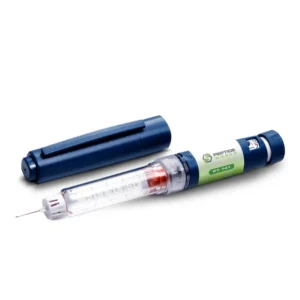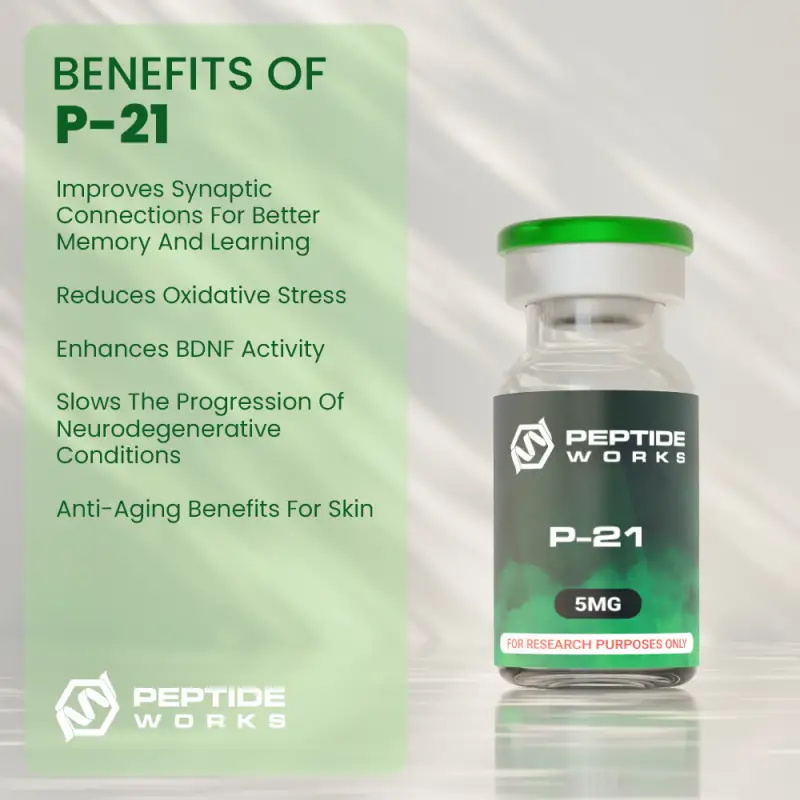PROMO!
First order? Get 10% OFF with this code: 1storder
Our Product Categories



P-21 is a synthetic neuroprotective peptide derived from ciliary neurotrophic factor (CNTF), a protein recognized for enhancing neurotransmitter synthesis and neuronal survival. Ac-DGGL-NH2 is a simple but powerful tetrapeptide amide that makes up its molecular structure.
This peptide aims to mimic the beneficial effects of CNTF while also making it more stable and able to cross the blood-brain barrier, two major problems with the full-length protein. These characteristics make P-21 a highly intriguing focus in neurodegenerative disease research. Researchers are exploring its potential to enhance cognitive function, stimulate neurogenesis, and safeguard neurons from excitotoxicity and oxidative stress.
Peptide Sequence (IUPAC Condensed): DGGL-adamantane-G
Molecular Formula: C30H54N605
Molecular Weight: 578.3 g/mol
Synonym: P021

P-21 works by altering key intracellular signaling pathways that support neuronal survival and plasticity. It activates the Janus kinase/signal transducer and activator of transcription (JAK/STAT) and mitogen-activated protein kinase (MAPK/ERK) pathways by mimicking ciliary neurotrophic factor (CNTF).
This activation increases the production of neuroprotective proteins and anti-apoptotic factors, which protect neurons from harm. P-21 also helps synaptic plasticity and long-term potentiation (LTP) in the hippocampus, which is an important part of learning and memory. This dual action of protecting neurons and improving cognitive function makes it a promising drug in preclinical models of neurodegeneration.
Neurogenesis and Cognitive Function: Research has shown that P21 peptide enhances neurogenesis and cognitive function by promoting the proliferation and maturation of new neurons in the hippocampal dentate gyrus, an important area for memory formation [1].
Studies have demonstrated that it enhances synaptic plasticity, the brain’s ability to strengthen or weaken synaptic connections in response to activity, essential for learning and memory. This includes promoting dendritic branching (growth of neuron extensions) and synapse formation (connections between neurons) [2].
Research experiments have also shown that P21 increases brain-derived neurotrophic factor (BDNF) expression, supporting neuronal survival and plasticity. In aged rodents and Alzheimer’s models, P21 reversed cognitive decline, rescued synaptic deficits, and improved learning, making it a promising therapeutic candidate [3].
Neuroprotection and Alzheimer’s Disease Pathology: P21 peptide demonstrates neuroprotective effects and potential in mitigating Alzheimer’s-type pathology. In 3×Tg-AD mice, P21 treatment reduced tau hyperphosphorylation, slowed amyloid-β (Aβ) pathology progression, and prevented neurodegeneration. It also rescued episodic memory impairments and reduced mortality rates.
Additionally, P21 decreased markers of glial activation, such as astrogliosis and microgliosis, in retinal studies, suggesting broader anti-inflammatory effects in the central nervous system. By enhancing neurogenesis, synaptic plasticity, and neuronal health, P21 offers promise as a therapeutic candidate for Alzheimer’s disease and other neurodegenerative conditions, potentially preventing cognitive decline and preserving neural integrity in aging and disease contexts.
Mechanistic Pathways: Research has shown that P21 peptide has an effect on important mechanistic pathways. It raises levels of Brain-Derived Neurotrophic Factor (BDNF), which in turn activates TrkB/PI3K/Akt/GSK-3β signaling downstream. This helps neurons stay alive, supports synaptic plasticity, and promotes protein synthesis, all of which are important for synaptic development. This pathway controls transcription, translation, and protein movement, all of which are important for neurogenesis and plasticity [7].
P21 also blocks signaling by Leukemia Inhibitory Factor (LIF), which promotes cell cycle arrest and apoptosis. P21 promotes neurogenesis and reduces the negative effects on neuronal development by blocking LIF signaling. These two mechanisms make P21 a promising treatment for neurodegenerative and cognitive disorders that can improve neurogenesis, synaptic health, and resilience [8].
Stability and Delivery Improvements: Research shows that the P21 peptide is more stable and better delivered than larger neurotrophic proteins, like CNTF. Because P21 is a small peptide, it can cross the blood-brain barrier (BBB) more easily and remains stable longer in plasma and the gut. This means it reaches the brain more effectively.
These characteristics make P21 a promising treatment because it avoids the common problems with larger proteins, such as poor BBB penetration and quick breakdown, ensuring better delivery and effectiveness for neurodegenerative and cognitive disorders [9].
[1] B Li, L Wanka, J Blanchard, et al (2010) Neurotrophic peptides incorporating adamantane improve learning and memory, promote neurogenesis and synaptic plasticity in mice – FEBS Letters, 2010 Aug 4, Volume 584 (Issue 15), Pages 3359-65.
[2] N Mottolese, M Loi, S Trazzi, et al (2024) Effects of a ciliary neurotrophic factor (CNTF) small-molecule peptide mimetic in an in vitro and in vivo model of CDKL5 deficiency disorder – Journal of Neurodevelopmental Disorders, 2024 Nov 26, Volume 16, Page 65.
[3] N Baazaoui and K Iqbal (2017) Prevention of dendritic and synaptic deficits and cognitive impairment with a neurotrophic compound – Alzheimer’s Research & Therapy volume 9, Article number: 45 (2017).
[4] M Mostafa, A Disouky, and O Lazarov (2025) Therapeutic modulation of neurogenesis to improve hippocampal plasticity and cognition in aging and Alzheimer’s disease – Neurotherapeutics, 2025 Apr 2, Volume 22 (Issue 3), Page e00580.
[5] N Baazaoui and K Iqbal (2017) Prevention of Amyloid-β and Tau Pathologies, Associated Neurodegeneration, and Cognitive Deficit by Early Treatment with a Neurotrophic Compound – Journal of Alzheimers Disease, 2017, Volume 58 (Issue 1), Pages 215-230.
[6] Y Liu, W Wei, N Baazaoui, et al (2019) Inhibition of AMD-Like Pathology With a Neurotrophic Compound in Aged Rats and 3xTg-AD Mice – Frontiers in Aging Neuroscience, 2019 Nov 19, Volume 11, Page 309.
[7] A Yoshii and M Constantine-Paton (2010) Postsynaptic BDNF-TrkB signaling in synapse maturation, plasticity, and disease – Developmental Neurobiology, 2010 Apr, Volume 70 (Issue 5), Pages 304-22.
[8] L Humbert, M Ghozlan, L Canaff, et al (2015) The leukemia inhibitory factor (LIF) and p21 mediate the TGFβ tumor suppressive effects in human cutaneous melanoma – BMC Cancer, 2015 Mar 29, Volume 15, Page 200.
[9] L Jiang, J Tian, J Yang, et al (2024) p21 Regulates Wnt-Notch balance via DREAM/MMB/Rb-E2F1 and maintains intestinal stem cell homeostasis – Cell Death Discovery volume 10, Article number: 413 (2024).
The answers to the most frequently asked questions about P-21.

P-21 peptide supports brain health by protecting neurons and improving memory in research studies. It encourages the growth of new nerve cells and strengthens connections between existing ones. In animal models, P-21 improved learning ability and restored damaged brain pathways linked to memory. These findings suggest that P-21 may help maintain healthy brain function and resilience against age-related decline.
P-21 peptide shows strong promise in Alzheimer’s research. In animal studies, it improved memory, supported the growth of new brain cells, and reduced harmful changes linked to the disease, such as tau buildup and amyloid deposits. It also helped brain cells connect and function better. These findings suggest P-21 may help protect the brain and support healthy cognitive function.
P-21 is a peptide with a small chemical modification that helps it cross the blood–brain barrier more easily. This change makes it more fat-soluble and allows it to reach brain tissue more effectively than many other peptides. Animal studies show that P-21 supports memory and neuron growth, suggesting it can act within the brain once absorbed.
Yes, P-21 peptide can be legally purchased in the United States for research purposes. It is not approved by the Food and Drug Administration (FDA) for human use, but reputable research suppliers can offer it for laboratory and scientific studies. Laws and regulations may vary by region, so always review local guidelines before purchasing.

This blog explores the comparison between the P-21 peptide and Cerebrolysin, focusing on their roles in brain research. It explains how P-21 is designed to support memory and learning, while Cerebrolysin offers a broader and more complex composition. The article also looks at their mechanisms, research reliability, and applications in neurodegenerative studies, providing insight into their distinct contributions to modern brain science.

This blog explores the fascinating world of cognitive peptides such as P-21, Semax, and Selank. It looks at their potential to improve memory, focus, and emotional balance, while explaining their mechanisms, research safety, and possible future uses in neuroscience. Learn how these peptides could help shape new approaches to brain health and resilience.

This blog explores the fascinating world of nootropic peptides such as Selank, Semax, and P-21, and their potential to support memory, focus, and overall brain health. It explains how these compounds work, from mood regulation to neuroprotection, and looks at their growing role in cognitive performance, learning, and long-term neural resilience.
ALL CONTENT AND PRODUCT INFORMATION AVAILABLE ON THIS WEBSITE IS FOR EDUCATIONAL PURPOSES ONLY.
DISCLAIMER: These products are intended solely as a research chemical only. This classification allows for their use only for research development and laboratory studies. The information available on our Peptide Works website: https://peptide-works.com/ is provided for educational purposes only. These products are not for human or animal use or consumption in any manner. Handling of these products should be limited to suitably qualified professionals. They are not to be classified as a drug, food, cosmetic, or medicinal product and must not be mislabelled or used as such.